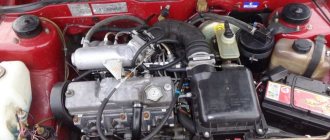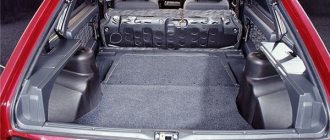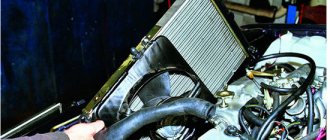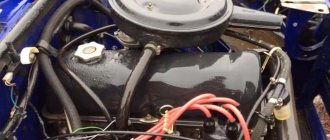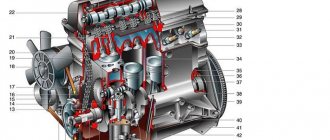One of the most famous developments of Soviet motor vehicles is the VAZ 2109 engine and its various modifications. Thus, the motor, which was developed back in 1982, serves faithfully to this day. This is one of the most common engines in the CIS.
It must be said that this is not considered one of the reliable units, but it is very repairable, which makes it quite popular among car enthusiasts.
Description and modifications
As such, a “nine” engine does not exist in nature. At least, the AvtoVAZ plant did not produce it. All 2109 models were equipped with a figure-eight power unit and its modifications. Of course, in many documents you can find the VAZ 2109 engine, but this is deception or ignorance.
But in the technical documentation of the manufacturer you cannot find information about the 2109 engine, since such an engine does not exist. Over the entire period of their production, all “nines” were equipped with engines with the following markings: VAZ-21081 (1.1 8V), VAZ-2108 (1.3 8V), VAZ-21083 (1.5 8V), VAZ- 2111-80 (1.5i 8V) and VAZ-11183-20 (1.6i 8V).
Candles
First of all, find out if there is a spark at all. The weakness of the latter allows you to start the engine while it remains hot, but it does not work when it is cold.
Unscrew the spark plug, place it against ground and crank the starter. If there is a spark, then there is probably a problem in the fuel system. We will tell you about it later.
It is necessary to do otherwise when the unscrewed spark plug works properly, but it turns out to be wet. Here you should check the timing belt. The latter sometimes jumps off, which disrupts the correct gas distribution and, accordingly, the VAZ engine does not want to start.
If you see that the spark plugs are filled with fuel, then perhaps this very circumstance is preventing you from starting the engine. Dry them with a burner or on a gas stove burner. When they turn out to be wet again during the next attempt, you will have to find out why this happened.
If there is no spark, the cause is sought further. It often lies in problems:
- crankshaft pulley or sensor that controls its position (DCPV);
- computer.
In most cases, the VAZ model 2109 injector does not want to start precisely because of the failure of the DPKV. Failure of other sensors does not prevent the engine from starting, it will simply not work correctly.
First, check whether the connector leading to it is intact and whether the wires are in good condition. It is the destruction or contamination of these elements that most often interferes with the normal operation of the DPKV, while the device itself is reliable.
To test the sensor, just hold a piece of metal close to it and measure the output voltage. It will fall if the piece of iron is taken away, and rise when it is brought close.
Another reason why a VAZ may not start is the crankshaft pulley. The disadvantage of this unit is that its teeth are partially made of rubber, which means they can come off or even scroll. This affects the sensor readings, and the computer, guided by them, does not want to supply voltage to the spark plugs. It’s not difficult to check - remove the casing from the timing belt (inspect it at the same time), and then examine the pulley.
There is a high probability that there is no spark due to a faulty ignition. First you should make sure that the connector leading to it is intact. Installing a known-good module on a Lada that does not want to start will allow you to confirm your suspicions.
It is imperative to inspect all wires. A break in them, even with working devices, often leads to the inability to start the engine.
Specifications
All engines that were installed on the VAZ 2109 were small in volume, but had sufficient power characteristics and dynamics. But things didn’t work out with the traction power. The engine power of the VAZ 2109 ranges from 54 to 81 horsepower. It is worth considering each engine option and its technical characteristics separately.
21081 (1.1 8V)
| Name | Index |
| Volume | 1.1 liter (1099 cc) |
| Number of cylinders | 4 |
| Number of valves | 8 |
| Fuel | Petrol |
| Injection system | Carburetor |
| Fuel consumption | 6,7 |
| Cylinder diameter | 76 |
| Cylinder operating order | 1-3-4-2 |
2108 (1.3 8V)
| Name | Index |
| Volume | 1.3 liters (1289 cc) |
| Number of cylinders | 4 |
| Number of valves | 8 |
| Fuel | Petrol |
| Injection system | Carburetor |
| Fuel consumption | 7.0 l |
| Cylinder diameter | 76 |
| Cylinder operating order | 1-3-4-2 |
21083 (1.5 8V)
| Name | Index |
| Volume | 1.5 liters (1499 cm3) |
| Number of cylinders | 4 |
| Number of valves | 8 |
| Fuel | Petrol |
| Injection system | Carburetor |
| Fuel consumption | 7.0 l |
| Cylinder diameter | 76 |
| Cylinder operating order | 1-3-4-2 |
2111-80 (1.5i 8V)
| Name | Index |
| Volume | 1.5 liters (1499 cm3) |
| Number of cylinders | 4 |
| Number of valves | 8 |
| Fuel | Petrol |
| Injection system | Injector |
| Fuel consumption | 7.5 l |
| Cylinder diameter | 82 |
| Cylinder operating order | 1-3-4-2 |
11183-20 (1.6i 8V)
| Name | Index |
| Volume | 1.6 liters (1596 cc) |
| Number of cylinders | 4 |
| Number of valves | 8 |
| Fuel | Petrol |
| Injection system | Injector |
| Fuel consumption | 9.5 l |
| Cylinder diameter | 82 |
| Cylinder operating order | 1-3-4-2 |
As you can see, the evolution of engines has come from the carburetor type to the injection type. Although with an increase in engine volume, fuel consumption also increased proportionally.
Another important fact remains the question: where is the engine number on old models of engines? As you know, the engine number was stamped on the cylinder block only from 1984 and on earlier versions that were exported. Therefore, you shouldn’t even look for this identifier on a 1983 power unit, since it simply doesn’t exist.
Body
| Body type | hatchback |
| Number of doors | 5 |
| Number of seats | 5 |
| Wheelbase | 2460 mm |
| Front track | 1400 mm |
| Rear track | 1370 mm |
| Ground clearance | 160 mm |
| Trunk volume is minimal | 270 l |
| Maximum trunk volume | 1000 l |
| Width | 1650 mm |
| Length | 4006 mm |
| Height | 1402 mm |
This is interesting: What is the weight of the VAZ 2101 block
Repair and service
On average, repairs to internal combustion engines of VAZ 2109 modifications are done based on mileage. This figure is about 200,000 km. Engine overhauls are carried out similarly to any Zhiguli power unit. Since, compared to the Volgovsky engine, the Vazovsky is quite small, motorists often do the bulkhead in their garage with their own hands.
The 2109 engine is highly repairable, since the cast iron block is quite difficult to destroy, and the cost of the head is low, which allows you to repair the internal combustion engine cheaply and without much expense with your own hands. Another positive factor in the repair is that the power unit is simple in design and even inexperienced car enthusiasts are able to carry out minor repairs to the VAZ 2109 engine with their own hands.
The main problems that many people face include: changing the oil in the VAZ 2109 engine, replacing spark plugs and high-voltage wires, as well as overhauling and adjusting the carburetor. By the way, almost all engines were equipped with an excellent injection element, which everyone knows as “Solex”.
Another question that car enthusiasts often ask is how much oil should be poured into the engine? This indicator depends on the type of motor. For example, for a VAZ-21081 this will be one indicator, but for a VAZ −11183-20 it will be completely different. Therefore, if a motorist wants to know how much oil is in his power unit, he needs to look at the technical documentation.
Other
VAZ 2109 21093 1.5 MT is a 5-door car with a 5-speed gearbox. With the number of seats for the driver and passengers: 5. The maximum permissible speed is 156 km/h. Acceleration time to 100 km/h is 14 seconds. Average fuel consumption per 100 km is: in the urban cycle - 8 liters, on the highway - 5.5 liters, in the combined cycle - 7.7 liters. The volume of the fuel tank is 43 liters. A full tank is enough for approximately: 538 km when driving around the city, 782 km when driving on the highway, 558 km when driving the combined cycle. The maximum load capacity of the vehicle is 425 kg.
- Fuel consumption VAZ 2109, 5 doors. hatchback
- Maximum speed VAZ 2109, 5 doors. hatchback
- Dimensions and dimensions of VAZ 2109, 5 doors. hatchback
- Acceleration to 100 km/h VAZ 2109, 5 doors. hatchback
This is interesting: What is the ground clearance of the Mazda 3
Tuning
Tuning the VAZ 2109 engine is quite simple and without any particular difficulties. So, the first thing motorists do to their engine is change the ignition system. Of course, on older models there is a contact version installed, which has long been obsolete, and therefore contactless is installed.
At the same time, spark plugs and high-voltage wires are changed. Don't forget about the ignition coil either. All this will give improved fuel combustion in the cylinders only if everything is configured correctly.
Next comes boring and reassembly of the cylinder block. So, many car enthusiasts install a sports piston version, which provides a lightweight crankshaft, pistons and connecting rods. Then, the guide bushings and valves are changed. All these modifications will give an increase in power by about 25-30 horses.
The last stage is external tuning. This may include: installing a zero-resistance air filter, overhauling the carburetor, replacing water cooling pipes, installing an improved pump and generator.
Do not forget about such an important element as the starter, a range of varieties that can be found in tuning stores. It is also recommended to replace the radiator with a lighter one, that is, install an aluminum one. All this will give more opportunities for the engine, and accordingly for the motorist.
Fuel system
If there is a spark in a carburetor or injection engine, it should be assumed that the car does not start due to problems in the fuel supply system.
First make sure that gasoline is flowing into the injectors. If not, then look at the VAZ fuel pump. It is equipped with an electric motor and is located directly in the tank. Normally, when the ignition is activated, it starts to make noise.
It is advisable to find out whether the pressure in the ramp is normal. Measure it with a pressure gauge - there is a special fitting for it. Connect the device to it - if the reading is 4 atmospheres, then everything is in order. Low pressure appears due to a clogged fuel filter; this element will have to be removed and cleaned.
If there is no positive result, move on to the injectors. When they become clogged, gasoline either stops flowing altogether or its volume noticeably decreases. Moreover, it does not spray, but only drips. This problem does not make itself felt while the engine is hot. In frosty weather, the car, even if it starts moving, will still not be able to develop normal power.
In addition, fuel atomization does not occur when the computer does not open the injectors. Make sure they have all the wires and are securely attached.
Conclusion
The VAZ 2109 engine, or rather its varieties that were installed on the car, became legends of the Soviet automobile industry. So, having a fairly small size, it was powerful, which gave it great popularity among motorists. Another positive factor was that repairing the VAZ 2109 engine is quite easy to do with your own hands, which allows any car enthusiast to reduce costs at a car service center.
With the popularization of tuning, most drivers who owned 2109 engines began to carry out modifications and, as practice shows, quite successfully.
Lubricating parts
Combined engine lubrication device for the VAZ-2109 (2110). Oil is supplied to the main and connecting rod bearings, as well as to the camshaft supports under pressure; the cylinders, pistons, pins and rings, camshaft cams and pushers are lubricated by splashing; all other associated parts are lubricated by gravity.
A gear-type oil pump with a bypass valve is installed at the front of the block. The oil receiver is mounted using bolts on the cover of the second main bearing and the pump housing. The oil filter is non-separable and has bypass and anti-drainage valves. The design of the lubrication system and other engine systems is discussed in detail in separate articles. » alt=»»> Crankcase ventilation is forced, gases are removed through the oil separator.
Source
When adjustment is necessary
Valve adjustment is required when problems occur with the engine or after passing a technical inspection. Experienced car owners can quite accurately determine the cause of a power unit malfunction; the main signs are the following:
- the appearance of a characteristic knocking sound when the engine is running;
- a sharp increase in fuel consumption;
- Unstable operation at idle.
Valve adjustment is also required after every 25-30 thousand kilometers . During this time, some parts wear out and structural gaps increase. Diagnostics can be done at a service center; this service is inexpensive.
The procedure for adjusting the carburetor on a VAZ 2109
1. A hot engine must be cooled to an outside temperature of 20-30 degrees. To speed up the process, use a regular household fan directed into the engine compartment. The front right wheel needs to be hung on a jack or stand.
2. To do the work yourself, remove the timing belt cover, unscrew the breather hoses and disconnect the gas and choke cables from the carburetor. Remove the explosive wires and unscrew the spark plugs. Then you can remove the valve cover.
3. Pump out the oil from the valve wells with a syringe, and by rotating the wheel, set the TDC for cylinder 1. In this position, intake valves 3 and 2 are adjusted, exhaust valves 5 and 1.
Remove the washer using tweezers
4. Check the gap with feeler gauges. The gap is considered normal when the smallest feeler gauge (0.15 for intake, 0.3 for exhaust) enters easily, the middle one (0.2 or 0.35) with little effort, and the largest one (0.25 or 0.4) - Excluded. If this is not the case, adjustment is required.
5. Use a special tool or slotted screwdriver to depress the adjustable valve spring. Remove the washer with tweezers and replace it with a larger one if the gap is large or a smaller one if the gap is small. Repeat the measurement. If necessary, install a washer of the next size in order.
6. Rotate the wheel to TDC for the next pair of cylinders. In this position the remaining valves are adjusted. Repeat measuring and replacing (if necessary) washers.
The adjustment process on cars with an injector is similar to a carburetor. The only difference is in the preparation. To free access to the cylinder head cover, only the gas cable and breather hose are removed.
Adjusting valves on VAZ 2109 cars is simple and even a beginner can do it. At the same time, it helps to better understand the structure of the car and solve a number of engine problems. Therefore, it is best to perform this operation at least once every 30-40 thousand kilometers.
Preparatory work
From the adjustment tool you will need:
- set of wrenches;
- special device for adjustment;
- measuring probe;
- several adjusting washers;
- screwdriver;
- tweezers;
- valve cover gaskets.
Before starting the repair, set the car to the handbrake and engage any gear. One of the front wheels must be suspended so that the crankshaft can turn easily.
The procedure is as follows:
- Raise the hood.
- Disconnect all pipes from the cover.
- Remove the windshield wiper housing.
- We unscrew the spark plugs.
- Remove the front timing belt cover.
Tip: To monitor the current position of the piston, you need to use the viewing window.
Which adjustment devices are best to choose?
Conventional tools are not suitable for precise and quick adjustments . Special devices are used with which you can fix the pusher and carry out other work. Today there are special adjustment kits on sale, their cost is low. Purchasing such a kit will be more profitable than trying to make devices from improvised means. Not everyone will be able to find suitable materials and make a dipstick or clamp correctly, and in case of poor-quality repairs, engine performance can become even worse.
Fines for crossing the stop line and speeding will no longer bother you!
